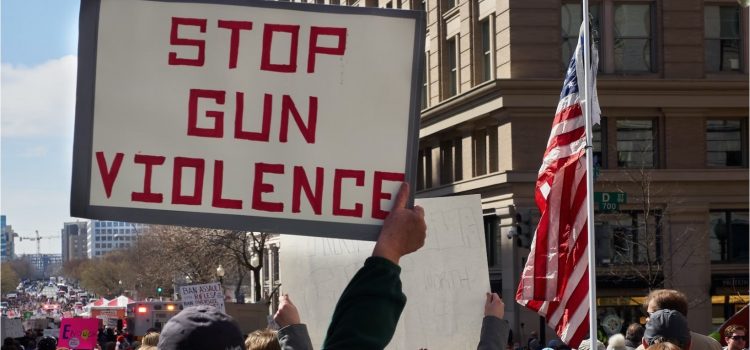
This is a free excerpt from one of Shortform’s Articles. We give you all the important information you need to know about current events and more.
Don't miss out on the whole story. Sign up for a free trial here .
Why do mass shootings happen in America so frequently? What are the best measures to prevent mass shootings?
According to reports, there have already been 600 mass shootings in the United States in 2022. To understand why mass shootings happen in America, researchers seek to learn what motivates mass shooters, whether it be mental illness, easy access to guns, or something else.
Read on to learn both sides of the debate seeking to answer why mass shootings happen in America.
Mass Shootings in America
As of mid-November, there had been 600 mass shootings in the United States in 2022, meaning an average of more than two per day. According to data reported by The Washington Post, not a single week has passed this year without at least four mass shootings. This data is based on The Gun Violence Archive’s definition of a “mass shooting” as an event in which at least four victims are shot, not including the perpetrator. So, why do mass shootings happen in America so much more frequently than the rest of the world?
Mass shootings are a uniquely American phenomenon, as the U.S. has the most mass shootings by far of any developed country in the world. William Paterson University’s Department of Sociology and Criminal Justice found that between 1998-2019, the U.S. accounted for 73% of the mass shooting incidents in the developed world. There are two major sides of the debate concerning why these tragedies happen so frequently in America: One side places the blame on mental illness, and the other on the availability of guns. Are both sides a bit disingenuous in their finger-pointing? As with most dichotomies, the truth probably lies somewhere in the middle, and in this case some other factors may also be at play.
Mental Illness as a Contributor
On November 9, Nikolas Cruz, who killed 17 people at Parkland High School was spared the death penalty and given life in prison. His defense attorney described him as a “brain damaged, broken, mentally ill person, through no fault of his own.”
Public discourse around the issue of mass shootings happening in America is heavily focused on mental health. Arguments pointing squarely to mental illness, however, are often meant to point the finger away from the issue of gun access. But mental health advocates say focusing solely on mental illness stigmatizes the mentally ill and oversimplifies the issue of why mass shootings are happening in America.
The link between mass shootings and mental health has been examined in numerous research studies, with mixed conclusions. Studies have estimated the rate of mental illness among mass murderers to be anywhere from 5% to more than 70%. This vast discrepancy is caused by two factors:
- The definition of “mental illness”: Most studies only looked for links between severe mental illness, such as psychosis, a form of mental illness that causes detachment from reality. A study conducted by the Violence Project found that psychosis played no role in about 70% of mass shootings. Other studies have shown even lower rates of psychosis among mass shooters. These studies don’t account for other types of mental illness that might be contributing factors.
- The difference between a diagnosis and exhibited behavior: Many people with mental health problems never get diagnosed. Men, who commit the vast majority of mass shootings , are less likely than women to seek mental health treatment and receive diagnosis. A 2020 study found that two-thirds of all mass shooters exhibited signs of mental illness, whether they were diagnosed or not. So diagnosed conditions may not be a reliable indicator of mental illness.
Regardless of percentage discrepancies, researchers tend to agree on one thing: mental illness alone is not a sufficient explanation for mass shootings. The vast majority of people with mental illnesses, even serious ones, do not commit violent acts. The Pew Research Center says that more than half of all Americans will be diagnosed with a mental illness or disorder at some time in their life. Since this implies that a higher proportion will exhibit symptoms but go undiagnosed, that means mass shooters are not necessarily statistically worse off than the general population.
Another factor that comes into play here is that if mental illness alone could explain mass shootings, we would see them happening at similar rates in other countries—America is not the most mentally healthy country in the world, but neither is it the most mentally unhealthy.
Where the U.S. does stand out globally, however, is in the rate of gun ownership. This leads many to point the finger at easy access to firearms as a major contributor to why mass shootings happen more frequently in America.
Gun Access as a Contributor
The U.S. has by far the highest number of firearms per resident of any country in the world, having more than double the per capita firearm count of the second country on the list (Yemen). It’s the only country in the world that has more citizen-owned firearms than it has citizens. Gun control advocates point out that it’s no coincidence that America far outpaces the rest of the developed world in both rates of mass shootings and the number of guns.
Statistics also do show that decreased access to guns and tighter gun control regulations make a difference. Australia had four mass shootings between 1987 and 1996. The perpetrator in the 1996 shooting killed 35 people in a popular tourist area. As a response, there was a public outcry for tighter gun control, and the Prime Minister banned rapid-fire rifles and shotguns and imposed stricter controls on gun licensing. In the 26 years since, Australia has not had a single mass shooting event.
Despite this example, many Americans tend to have a more favorable view of gun ownership after a mass shooting event, and many will point out that just as most mentally ill people will never commit a mass shooting, neither will most gun owners. So, the U.S. is unlikely to follow Australia’s lead.
Other Contributing Factors
If neither mental illness nor gun access is sufficient in itself to explain mass shootings, what other factors might come into play? Some experts say we should think more in terms of “crisis” than mental illness.
First, let’s take a look at what we know statistically about people who commit mass shootings in America:
- They are overwhelmingly male (97%), with the majority being white and under 35.
- They are prone to holding extremist ideologies, often being radicalized by internet content.
- They tend to have a grievance about a perceived injustice, for which they blame some group of people.
- They often have fame and notoriety-seeking motives.
Researchers say the combination of these things with easy access to guns can create the perfect storm. They say mass shooters should better be understood as hate-motivated “terrorists” or as being “in crisis” than as mentally ill, and that the lack of a diagnosable mental illness does not necessarily imply mental wellness.
Criminal Justice Professor Eric Madfis places a large portion of the blame on the way boys are socialized. He says American culture teaches boys that masculinity is tied to unhealthy repression of emotion, and to aggression, and that many of these mass shooters have felt rejected and emasculated in one way or another.
Another explanation of why mass shootings happen in America is that many mass shooter incidents appear to be “copycats” of prior events. Each shooting increases the chances that others will occur soon afterward.
Recognizing the Signs of Crisis
According to experts, to prevent mass shootings in America, one of the best prevention measures we can take is to learn to recognize the signs of crisis. One evidence-based policy that has been implemented in 19 American states is what’s known as a “red flag law,” which allows a judge to remove firearms from a person who has exhibited dangerous behaviors that indicate the potential for violence.
The Violence Project’s database shows that four out of five mass shooters exhibited signs of crisis leading up to the event.
According to the FBI, some of the most prominent warning signs include:
- Uncharacteristically angry, reckless, or aggressive behavior
- Changes in interpersonal communication or relationships
- Decline in work or school performance
- Drug and alcohol abuse
- Sudden interest in firearms or change in firearm behavior
- Changes in appearance, such as in personal hygiene or weight
- Telling others of plans for violence, known as “leakage”

Want to fast-track your learning? With Shortform, you’ll gain insights you won't find anywhere else .
Here's what you’ll get when you sign up for Shortform :
- Complicated ideas explained in simple and concise ways
- Smart analysis that connects what you’re reading to other key concepts
- Writing with zero fluff because we know how important your time is






